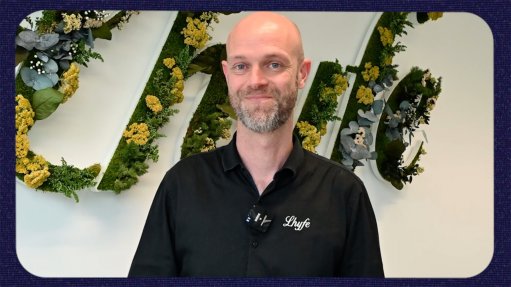Mantashe 'grapples' with difference between a permit and licence as 100-MW reform drafting nears completion
Mineral Resource and Energy Minister Gwede Mantashe says that a revised amendment to Schedule 2 of the Electricity Regulation Act, reflecting an increase in the licence-exemption cap from 1 MW to 100 MW, will be finalised within the coming week and will be shared with The Presidency “so that we reconcile our approach”.
However, speaking during an Absa event on Wednesday, Mantashe struck a somewhat ominous tone when he said that he and his officials were still grappling over the distinction between the registration “permit” to be issued by the National Energy Regulator of South Africa (Nersa) under the new regulation and a licence.
“I don’t know whether you listened to President [Cyril] Ramaphosa? He said that every project would have to be registered by Nersa and that Nersa must develop conditions for [the issuance of] a permit to operate,” Mantashe said in response to a question on the status of the amendment.
“In the department, we have had a discussion trying to understand the distinction between a permit and a licence and we came to the conclusion that, at the essence of the issue, is accelerating the process for people to start getting their permits to operate.
“But we cannot allow it to be a free for all, because it will cause chaos in the country.”
He promised, however, that no permit should take more than two months to process, saying “that remains the deal” he made with the President.
“I’m still trying to grapple with the difference between permitting and licencing, but two months is the maximum that we attach to it.”
“In the coming week we are hoping to issue the draft Schedule 2 . . . and we will hand it to the President so that we reconcile our approach,” Mantashe said.
He argued that, as part of the drafting process, questions had been posed about the objective of the amendment. “Are we deregulating energy, or are we deregulating renewable energy, or are we making it easier to operate? That question is being debated internally; we will answer it and Schedule 2, as revised and Gazetted, will talk to that issue,” he said.
Mantashe was speaking only a day after the Nersa electricity sub-committee, which will advise the Energy Regulator on its response to the 100 MW reform, took the unusual step of closing its deliberations on the matter to the public.
Typically, all Nersa meetings are open, but on July 6 Nersa close its virtual meeting to the public when discussing an analysis on the impact that the increase in the threshold to 100 MW would have on Nersa and the electricity industry.
While Ramaphosa’s June 10 announcement was warmly embraced by most stakeholders, some immediately warned that the content of the amendment would be crucial as there was a risk that the permit could evolve into a quasi-licence, which could further delay much-needed investment.
Prior to the announcement, Mantashe had displayed stout resistance to increasing the threshold beyond 10 MW, but indicated Ramaphosa had “twisted his arm” to support the move, which was strongly supported by the load-shedding-fatigued business sector, as well as civil society groups and parts of the labour movement.
Flanked by Mantashe, Ramaphosa surprised many by announcing that the licence-exemption cap on self- or embedded-generation plants would be increased to 100 MW rather than the 50 MW initially sought.
He also confirmed that these plants would also be allowed to wheel electricity through municipal and Eskom networks and sell surplus electricity to nonrelated buyers. They would still require grid-connection and environmental authorisations, however, before approaching Nersa for registration.
In response, business indicated that large investment would be unlocked, with the Minerals Council South Africa indicating that the mining industry alone was likely to invest R27-billion-worth in embedded generation projects.
Comments
Press Office
Announcements
What's On
Subscribe to improve your user experience...
Option 1 (equivalent of R125 a month):
Receive a weekly copy of Creamer Media's Engineering News & Mining Weekly magazine
(print copy for those in South Africa and e-magazine for those outside of South Africa)
Receive daily email newsletters
Access to full search results
Access archive of magazine back copies
Access to Projects in Progress
Access to ONE Research Report of your choice in PDF format
Option 2 (equivalent of R375 a month):
All benefits from Option 1
PLUS
Access to Creamer Media's Research Channel Africa for ALL Research Reports, in PDF format, on various industrial and mining sectors
including Electricity; Water; Energy Transition; Hydrogen; Roads, Rail and Ports; Coal; Gold; Platinum; Battery Metals; etc.
Already a subscriber?
Forgotten your password?
Receive weekly copy of Creamer Media's Engineering News & Mining Weekly magazine (print copy for those in South Africa and e-magazine for those outside of South Africa)
➕
Recieve daily email newsletters
➕
Access to full search results
➕
Access archive of magazine back copies
➕
Access to Projects in Progress
➕
Access to ONE Research Report of your choice in PDF format
RESEARCH CHANNEL AFRICA
R4500 (equivalent of R375 a month)
SUBSCRIBEAll benefits from Option 1
➕
Access to Creamer Media's Research Channel Africa for ALL Research Reports on various industrial and mining sectors, in PDF format, including on:
Electricity
➕
Water
➕
Energy Transition
➕
Hydrogen
➕
Roads, Rail and Ports
➕
Coal
➕
Gold
➕
Platinum
➕
Battery Metals
➕
etc.
Receive all benefits from Option 1 or Option 2 delivered to numerous people at your company
➕
Multiple User names and Passwords for simultaneous log-ins
➕
Intranet integration access to all in your organisation





















